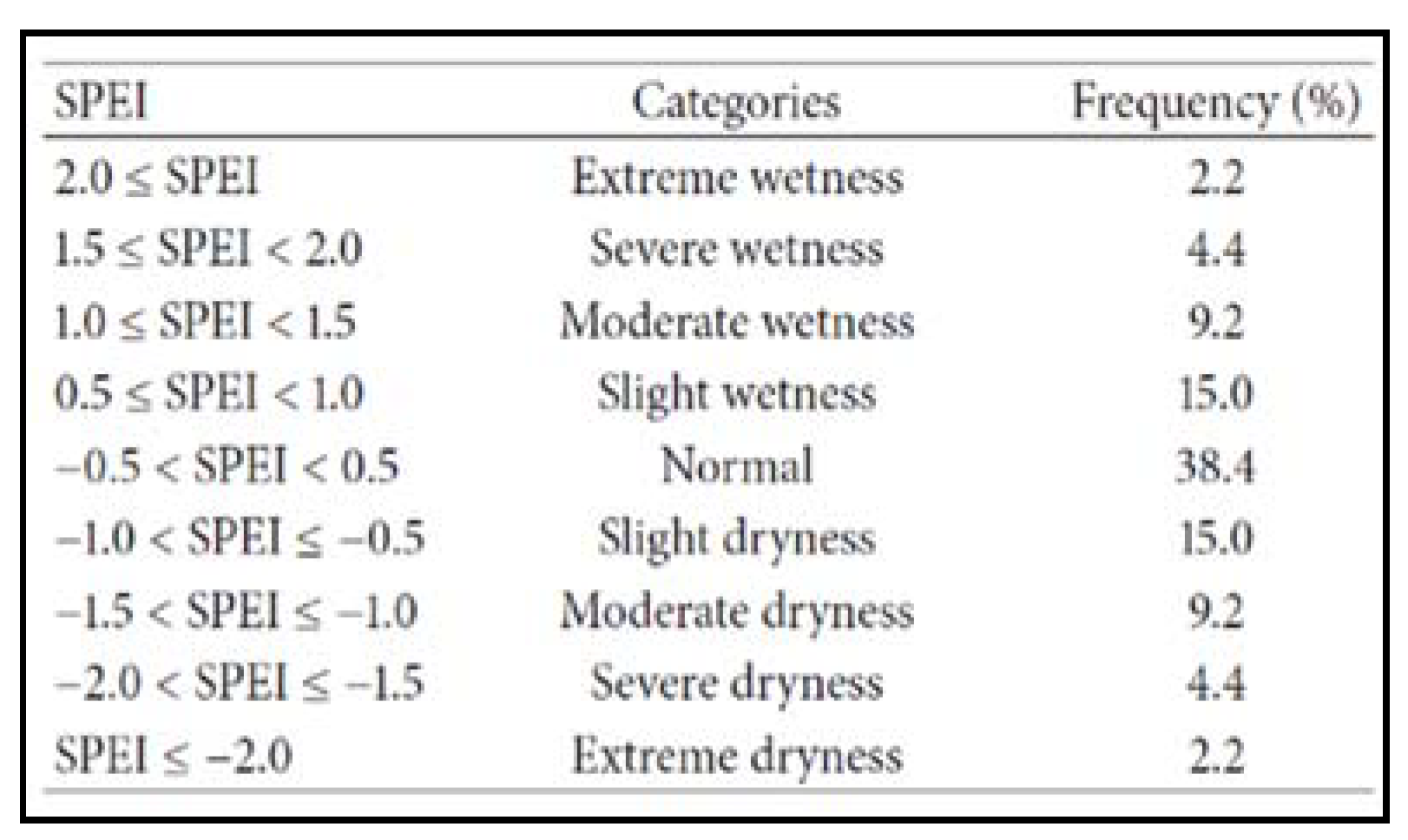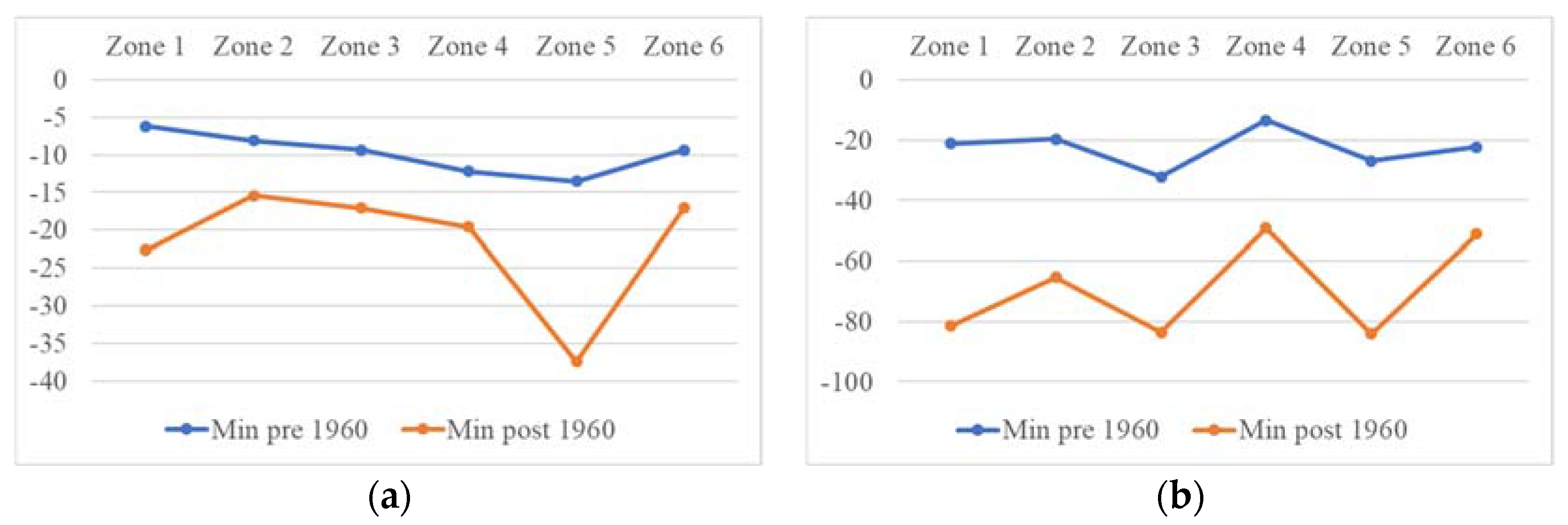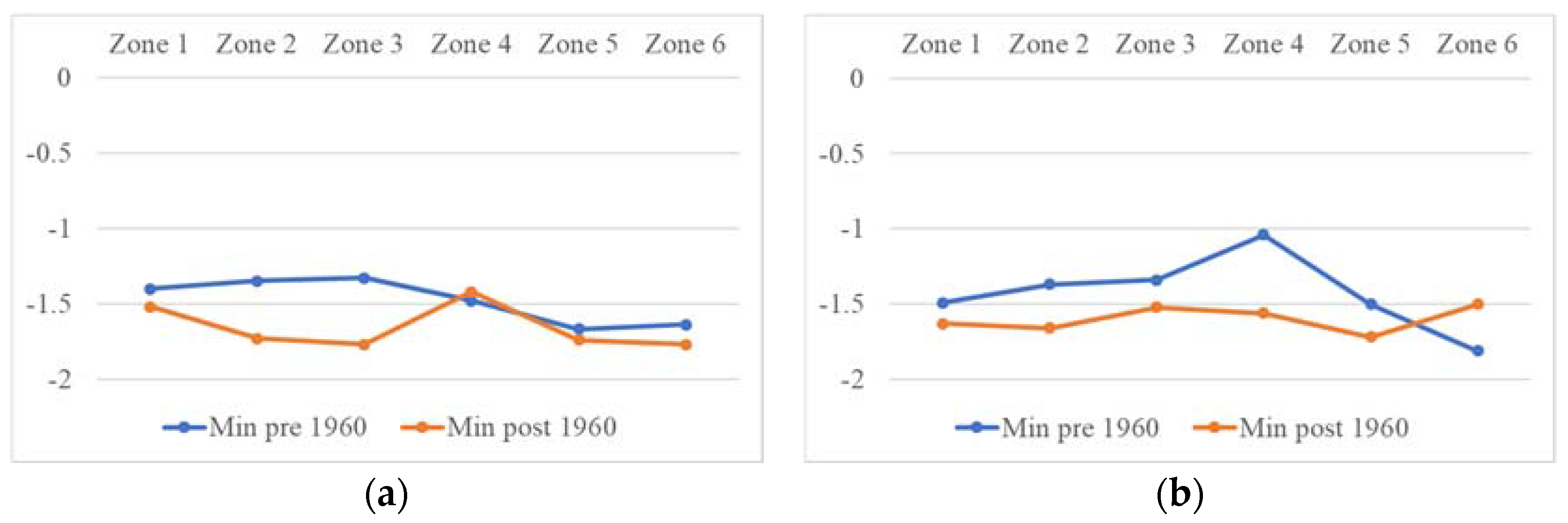Exploring the Evolution of Drought Characteristics in Balochistan, Pakistan
Abstract
:1. Introduction
2. Materials and Methods
2.1. Meteorological Data
2.2. Study Area
2.3. Drought Regionalization
2.4. Drought Characterization
2.5. Drought Trends and Evolution
3. Results
3.1. Drought Regionalization
3.2. 3-Month and 12-Month SPEI Time Series
3.3. Drought Characterization
3.4. Drought Evolution
4. Discussion
5. Conclusions
Author Contributions
Funding
Conflicts of Interest
References
- Panagoulia, D.G.; Dimou, G. Definitions and effects of droughts. Div. Water Resour. 1998, 7, 2–5. [Google Scholar]
- Dars, G.H.; Najafi, M.R.; Qureshi, A.L. Assessing the Impacts of Climate Change on Future Precipitation Trends Based on Downscaled CMIP5 Simulations Data. Mehran Univ. Res. J. Eng. Technol. 2017, 36, 385–394. [Google Scholar] [CrossRef] [Green Version]
- Mishra, A.K.; Singh, V.P. A review of drought concepts. J. Hydrol. 2010, 391, 202–216. [Google Scholar] [CrossRef]
- Edossa, D.C.; Woyessa, Y.E.; Welderufael, W.A. Spatiotemporal analysis of droughts using self-calibrating Palmer’s Drought Severity Index in the central region of South Africa. Theor. Appl. Clim. 2016, 126, 643–657. [Google Scholar] [CrossRef]
- Palmer, W.C. Meteorological Drought; US Department of Commerce; Weather Bureau: Melbourne, Australia, 1965; p. 58.
- Byun, H.R.; Wilhite, D.A. Objective quantification of drought severity and duration. J. Clim. 1999, 12, 2747–2756. [Google Scholar] [CrossRef]
- Thomas, M.B.; Nolan, D.J.; John, K. The Relationship of Drought Frequency and Duration to Time Scales. In Proceedings of the 8th Conference on Applied Climatology, Anaheim, CA, USA, 17–22 January 1993; Volume 17, pp. 179–183. [Google Scholar]
- Gocic, M.; Trajkovic, S. Spatiotemporal characteristics of drought in Serbia. J. Hydrol. 2014, 510, 110–123. [Google Scholar] [CrossRef]
- Dabanlı, İ.; Mishra, A.K.; Şen, Z. Long-term spatio-temporal drought variability in Turkey. J. Hydrol. 2017, 552, 779–792. [Google Scholar] [CrossRef]
- Ashraf, M.; Routray, J.K. Spatio-temporal characteristics of precipitation and drought in Balochistan Province, Pakistan. Nat. Hazards 2015, 77, 229–254. [Google Scholar] [CrossRef]
- Haroon, M.A.; Zhang, J.; Yao, F. Drought monitoring and performance evaluation of MODIS-based drought severity index (DSI) over Pakistan. Nat. Hazards 2016, 84, 1349–1366. [Google Scholar] [CrossRef]
- Xie, H.; Ringler, C.; Zhu, T.; Waqas, A. Droughts in Pakistan: A spatiotemporal variability analysis using the Standardized Precipitation Index. Water Food Secur. Chall. Pak. 2016, 38, 116–127. [Google Scholar] [CrossRef]
- Vicente-Serrano, S.M.; Beguería, S.; López-Moreno, J.I. A multiscalar drought index sensitive to global warming: The standardized precipitation evapotranspiration index. J. Clim. 2010, 23, 1696–1718. [Google Scholar] [CrossRef] [Green Version]
- Adnan, S. Spatio-Temporal Distribution of Drought and its Characteristics over Pakistan. Ph.D. Thesis, Commission on Science and Technology for Sustainable Development in the South University, Islamabad, Pakistan, 2016. [Google Scholar]
- Guo, H.; Bao, A.; Liu, T.; Jiapaer, G.; Ndayisaba, F.; Jiang, L.; Kurban, A.; De Maeyer, P. Spatial and temporal characteristics of droughts in Central Asia during 1966–2015. Sci. Total Environ. 2018, 624, 1523–1538. [Google Scholar] [CrossRef] [PubMed]
- Krakauer, N.Y.; Lakhankar, T. Trends in Drought over the Northeast United States. Water 2019, 11, 1834. [Google Scholar] [CrossRef] [Green Version]
- Potop, V.; Boronean, C. Observed evolution of drought episodes assessed with the Standardized Precipitation Evapotranspiration Index (SPEI) over the Czech Republic. EGU Gen. Assem. 2012, 14, 10010. [Google Scholar]
- Liu, X.; Wang, S.; Zhou, Y.; Wang, F.; Li, W.; Liu, W. Regionalization and Spatiotemporal Variation of Drought in China Based on Standardized Precipitation Evapotranspiration Index (1961-2013). Adv. Meteorol. 2015, 2015, 18. [Google Scholar] [CrossRef] [Green Version]
- Tan, C.; Yang, J.; Li, M. Temporal-spatial variation of drought indicated by SPI and SPEI in Ningxia Hui Autonomous Region, China. Atmosphere 2015, 6, 1399–1421. [Google Scholar] [CrossRef] [Green Version]
- Tian, L.; Quiring, S.M. Spatial and temporal patterns of drought in Oklahoma (1901–2014). Int. J. Climatol. 2019, 39, 3365–3378. [Google Scholar] [CrossRef]
- Dayal, K.S.; Deo, R.C.; Apan, A.A. Investigating drought duration-severity-intensity characteristics using the standardized precipitation-evapotranspiration index: Case studies in drought-prone southeast Queensland. J. Hydrol. Eng. 2018, 23, 1–16. [Google Scholar] [CrossRef]
- Deo, R.C.; Salcedo-Sanz, S.; Carro-Calvo, L.; Saavedra-Moreno, B. Drought Prediction with Standardized Precipitation and Evapotranspiration Index and Support Vector Regression Models; Elsevier: Amsterdam, The Netherlands, 2018; ISBN 9780128120576. [Google Scholar]
- Khan, M.I.; Liu, D.; Fu, Q.; Faiz, M.A. Detecting the persistence of drying trends under changing climate conditions using four meteorological drought indices. Meteorol. Appl. 2018, 25, 184–194. [Google Scholar] [CrossRef]
- Eckstein, D.; Künzel, V.; Schäfer, L.; Winges, M. Global Climate Risk Index 2020. Bonn Ger. 2019, 9. [Google Scholar]
- Sheikh, M.M. Drought management and prevention in Pakistan. Sci. Vis. 2001, 7, 117–131. [Google Scholar]
- Jamro, S.; Dars, G.H.; Ansari, K.; Krakauer, N.Y. Spatio-temporal variability of drought in Pakistan using standardized precipitation evapotranspiration index. Appl. Sci. 2019, 9, 4588. [Google Scholar] [CrossRef] [Green Version]
- McKee, T.B.; Doesken, N.J.; Kleist, J. Drought Monitoring with Multiple Time Scales; American Meteorological Society: Dallas, TX, USA, 1995; pp. 233–236. [Google Scholar]
- Andujar, E.; Krakauer, N.Y.; Yi, C.; Kogan, F. Ecosystem Drought Response Timescales from Thermal Emission versus Shortwave Remote Sensing. Adv. Meteorol. 2017, 2017, 10. [Google Scholar] [CrossRef] [Green Version]
- Hameed, M.; Ahmadalipour, A.; Moradkhani, H. Apprehensive drought characteristics over Iraq: Results of a multidecadal spatiotemporal assessment. Geosciences 2018, 8, 58. [Google Scholar] [CrossRef] [Green Version]
- Beguería, S.; Vicente-Serrano, S.M.; Reig, F.; Latorre, B. Standardized precipitation evapotranspiration index (SPEI) revisited: Parameter fitting, evapotranspiration models, tools, datasets and drought monitoring. Int. J. Climatol. 2014, 34, 3001–3023. [Google Scholar] [CrossRef] [Green Version]
- Guttman, N.B. Accepting the standardized precipitation index: A calculation algorithm. J. Am. Water Resour. Assoc. 1999, 35, 311–322. [Google Scholar] [CrossRef]
- Beguería, S.; Latorre, B.; Reig, F.; Vicente-Serrano, S.M. sbegueria/SPEIbase: Version 2.5.1. Glob. SPEI Database 2017. [Google Scholar]
- Harris, I.; Jones, P.D.; Osborn, T.J.; Lister, D.H. Updated high-resolution grids of monthly climatic observations—the CRU TS3.10 Dataset. Int. J. Climatol. 2014, 34, 623–642. [Google Scholar] [CrossRef] [Green Version]
- The World Bank. Pakistan—Balochistan Economic Report: From Periphery to Core (Vol. 2): Full Report; The World Bank: Washington, WA, USA, 2008; Volume II. [Google Scholar]
- BUITEMS. UNDP Drought Risk Assessment in the Province of Balochistan; BUITEMS: Quetta, Pakistan, 2015; p. 87. [Google Scholar]
- Zaman, Q.U.; Rasul, G. Agro-Climatic Classification of Pakistan. Q. Sci. Vis. 2004, 9, 59–66. [Google Scholar]
- About Balochistan—Government of Balochistan. Available online: www.balochistan.gov.pk/index.php?option=com_content&view=article&id=37&Itemid=783 (accessed on 20 December 2019).
- Assunção, R.M.; Neves, M.C.; Câmara, G.; Da Costa Freitas, C. Efficient regionalization techniques for socio-economic geographical units using minimum spanning trees. Int. J. Geogr. Inf. Sci. 2006, 20, 797–811. [Google Scholar] [CrossRef]
- Lage Palmieri, J.; Assunção, R.M.; Reis, E.A. A Minimal Spanning Tree Algorithm Applied to Spatial Cluster Analysis. Electron. Notes Discrete Math. 2001, 7, 162–165. [Google Scholar] [CrossRef]
- Jungnickel, D. Graphs, Networks and Algorithms; Springer: Berlin/Heidelberg, Germany, 1999. [Google Scholar]
- Yevjevich, V. An objective approach to definitions and investigations of continental hydrologic droughts. J. Hydrol. 1969, 7, 353. [Google Scholar]
- Kendall, M.G. Rank Correlation Methods; Griffin: Oxford, UK, 1948. [Google Scholar]
- Sen, P.K. Estimates of the Regression Coefficient Based on Kendall’s Tau. J. Am. Stat. Assoc. 1968, 63, 1379–1389. [Google Scholar] [CrossRef]
- da Silva, R.M.; Santos, C.A.G.; Moreira, M.; Corte-Real, J.; Silva, V.C.L.; Medeiros, I.C. Rainfall and river flow trends using Mann–Kendall and Sen’s slope estimator statistical tests in the Cobres River basin. Nat. Hazards 2015, 77, 1205–1221. [Google Scholar] [CrossRef]
- Joshi, N.; Gupta, D.; Suryavanshi, S.; Adamowski, J.; Madramootoo, C.A. Analysis of trends and dominant periodicities in drought variables in India: A wavelet transform based approach. Atmos. Res. 2016, 182, 200–220. [Google Scholar] [CrossRef]
- Pakistan Weather Portal History of Drought in Pakistan—In Detail. Available online: https://pakistanweatherportal.com/2011/05/08/history-of-drought-in-pakistan-in-detail/ (accessed on 19 September 2019).
- Durrani, Z.K. Lessons for Pakistan from Droughts in the Past. Available online: https://cscr.pk/explore/themes/energy-environment/lessons-pakistan-droughts-past/ (accessed on 20 July 2018).
- Centre, N.D.M. Drought Bulletin of Pakistan July-September 2019; Pakistan Meteorological Department: Islamabad, Pakistan, 2019.
- Baines, P.G.; Folland, C.K. Evidence for a rapid global climate shift across the late 1960s. J. Clim. 2007, 20, 2721–2744. [Google Scholar] [CrossRef] [Green Version]
- Lamb, H. Climate in the 1960’s Changes in the World’s Wind Circulation Reflected in Prevailing Temperatures, Rainfall Patterns and the Levels of the African Lakes. Geograohic. J. 1966, 132, 183–212. [Google Scholar] [CrossRef]
- Li, Y.; Ye, W.; Wang, M.; Yan, X. Climate change and drought: A risk assessment of crop-yield impacts. Clim. Res. 2009, 39, 31–46. [Google Scholar] [CrossRef]



















| Mann–Kendall Test Results for 3-Month SPEI | ||||
|---|---|---|---|---|
| p-Value | Tau | Sen’s Slope | ||
| Zone 1 | SPEI | 1.41 × 10−19 | −1.63 × 10−1 | −6.15 × 10−4 |
| Duration | 7.83 × 10−3 | 1.49 × 10−1 | 0.00 | |
| Severity | 2.52 × 10−4 | −2.13 × 10−1 | −1.23 × 10−2 | |
| Intensity | 5.66 × 10−6 | −2.64 × 10−1 | −2.79 × 10−3 | |
| Peak | 2.00 × 10−5 | −2.48 × 10−1 | −3.77 × 10−3 | |
| Zone 2 | SPEI | 3.94 × 10−5 | −7.42 × 10−2 | −2.76 × 10−4 |
| Duration | 1.20 × 10−1 | 8.15 × 10−2 | 0.00 | |
| Severity | 2.27 × 10−2 | −1.23 × 10−1 | −5.42 × 10−3 | |
| Intensity | 1.97 × 10−3 | −1.67 × 10−1 | −1.43 × 10−3 | |
| Peak | 6.78 × 10−4 | −1.83 × 10−1 | −2.09 × 10−3 | |
| Zone 3 | SPEI | 1.26 × 10−6 | −8.75 × 10−2 | −3.33 × 10−4 |
| Duration | 6.06 × 10−1 | 2.67 × 10−2 | 0.00 | |
| Severity | 3.43 × 10−1 | −5.06 × 10−2 | −1.85 × 10−3 | |
| Intensity | 1.67 × 10−1 | −7.37 × 10−2 | −6.22 × 10−4 | |
| Peak | 1.22 × 10−1 | −8.24 × 10−2 | −1.01 × 10−3 | |
| Zone 4 | SPEI | 3.83 × 10−4 | −6.41 × 10−2 | −2.43 × 10−4 |
| Duration | 2.81 × 10−1 | 5.45 × 10−2 | 0.00 | |
| Severity | 1.72 × 10−2 | −1.24 × 10−1 | −5.82 × 10−3 | |
| Intensity | 2.71 × 10−8 | −2.89 × 10−1 | −2.36 × 10−3 | |
| Peak | 8.11 × 10−8 | −2.79 × 10−1 | −3.17 × 10−3 | |
| Zone 5 | SPEI | 5.41 × 10−38 | −2.33 × 10−1 | −8.12 × 10−4 |
| Duration | 5.03 × 10−3 | 1.61 × 10−1 | 0.00 | |
| Severity | 5.44 × 10−4 | −2.04 × 10−1 | −1.20 × 10−2 | |
| Intensity | 1.62 × 10−4 | −2.23 × 10−1 | −2.31 × 10−3 | |
| Peak | 3.26 × 10−5 | −2.45 × 10−1 | −3.90 × 10−3 | |
| Zone 6 | SPEI | 1.44 × 10−2 | −4.41 × 10−2 | −1.67 × 10−4 |
| Duration | 1.87 × 10−2 | 1.32 × 10−1 | 0.00 | |
| Severity | 9.11 × 10−4 | −1.92 × 10−1 | −1.06 × 10−2 | |
| Intensity | 2.33 × 10−5 | −2.45 × 10−1 | −2.62 × 10−3 | |
| Peak | 1.12 × 10−4 | −2.24 × 10−1 | −3.44 × 10−3 | |
| Statistically significant at 95% confidence interval | ||||
| Not statistically significant | ||||
| Mann–Kendall Test Results for 12-Month SPEI | ||||
|---|---|---|---|---|
| p-Value | Tau | Sen’s Slope | ||
| Zone 1 | SPEI | 4.62 × 10−42 | −2.45 × 10−1 | −8.53 × 10−4 |
| Duration | 8.22 × 10−2 | 1.72 × 10−1 | 7.69 × 10−2 | |
| Severity | 1.47 × 10−1 | −1.45 × 10−1 | −5.41 × 10−2 | |
| Intensity | 7.29 × 10−1 | −3.55 × 10−2 | −1.18 × 10−3 | |
| Peak | 2.23 × 10−1 | −1.22 × 10−1 | −5.62 × 10−3 | |
| Zone 2 | SPEI | 1.86 × 10−8 | −1.02 × 10−1 | −3.86 × 10−4 |
| Duration | 7.00 × 10−1 | 3.63 × 10−2 | 0.00 | |
| Severity | 6.87 × 10−1 | −3.84 × 10−2 | −6.78 × 10−3 | |
| Intensity | 4.38 × 10−1 | −7.34 × 10−2 | −2.18 × 10−3 | |
| Peak | 3.25 × 10−1 | −9.29 × 10−2 | −3.98 × 10−3 | |
| Zone 3 | SPEI | 1.33 × 10−15 | −1.44 × 10−1 | −5.31 × 10−4 |
| Duration | 6.00 × 10−2 | 1.96 × 10−1 | 1.18 × 10−1 | |
| Severity | 2.29 × 10−2 | −2.39 × 10−1 | −1.95 × 10−1 | |
| Intensity | 9.42 × 10−4 | −3.47 × 10−1 | −1.18 × 10−2 | |
| Peak | 3.70 × 10−3 | −3.04 × 10−1 | −1.81 × 10−2 | |
| Zone 4 | SPEI | 6.19 × 10−6 | −8.16 × 10−2 | −3.13 × 10−4 |
| Duration | 1.32 × 10−2 | 2.49 × 10−1 | 1.54 × 10−1 | |
| Severity | 1.61 × 10−3 | −3.19 × 10−1 | −2.35 × 10−1 | |
| Intensity | 4.60 × 10−4 | −3.54 × 10−1 | −1.21 × 10−2 | |
| Peak | 1.02 × 10−2 | −2.60 × 10−1 | −1.63 × 10−2 | |
| Zone 5 | SPEI | 6.78 × 10−20 | −1.65 × 10−1 | −6.26 × 10−4 |
| Duration | 1.49 × 10−1 | 1.31 × 10−1 | 4.00 × 10−2 | |
| Severity | 1.28 × 10−1 | −1.39 × 10−1 | −4.77 × 10−2 | |
| Intensity | 2.81 × 10−2 | −2.01 × 10−1 | −3.98 × 10−3 | |
| Peak | 4.37 × 10−2 | −1.84 × 10−1 | −7.01 × 10−3 | |
| Zone 6 | SPEI | 1.16 × 10−2 | −4.56 × 10−2 | −1.69 × 10−4 |
| Duration | 2.68 × 10−2 | 1.81 × 10−1 | 3.64 × 10−2 | |
| Severity | 2.80 × 10−2 | −1.84 × 10−1 | −3.72 × 10−2 | |
| Intensity | 3.63 × 10−1 | −7.64 × 10−2 | −1.62 × 10−3 | |
| Peak | 1.24 × 10−1 | −1.29 × 10−1 | −3.94 × 10−3 | |
| Statistically significant at 95% confidence interval | ||||
| Not statistically significant | ||||
© 2020 by the authors. Licensee MDPI, Basel, Switzerland. This article is an open access article distributed under the terms and conditions of the Creative Commons Attribution (CC BY) license (http://creativecommons.org/licenses/by/4.0/).
Share and Cite
Jamro, S.; Channa, F.N.; Dars, G.H.; Ansari, K.; Krakauer, N.Y. Exploring the Evolution of Drought Characteristics in Balochistan, Pakistan. Appl. Sci. 2020, 10, 913. https://doi.org/10.3390/app10030913
Jamro S, Channa FN, Dars GH, Ansari K, Krakauer NY. Exploring the Evolution of Drought Characteristics in Balochistan, Pakistan. Applied Sciences. 2020; 10(3):913. https://doi.org/10.3390/app10030913
Chicago/Turabian StyleJamro, Shoaib, Falak Naz Channa, Ghulam Hussain Dars, Kamran Ansari, and Nir Y. Krakauer. 2020. "Exploring the Evolution of Drought Characteristics in Balochistan, Pakistan" Applied Sciences 10, no. 3: 913. https://doi.org/10.3390/app10030913






